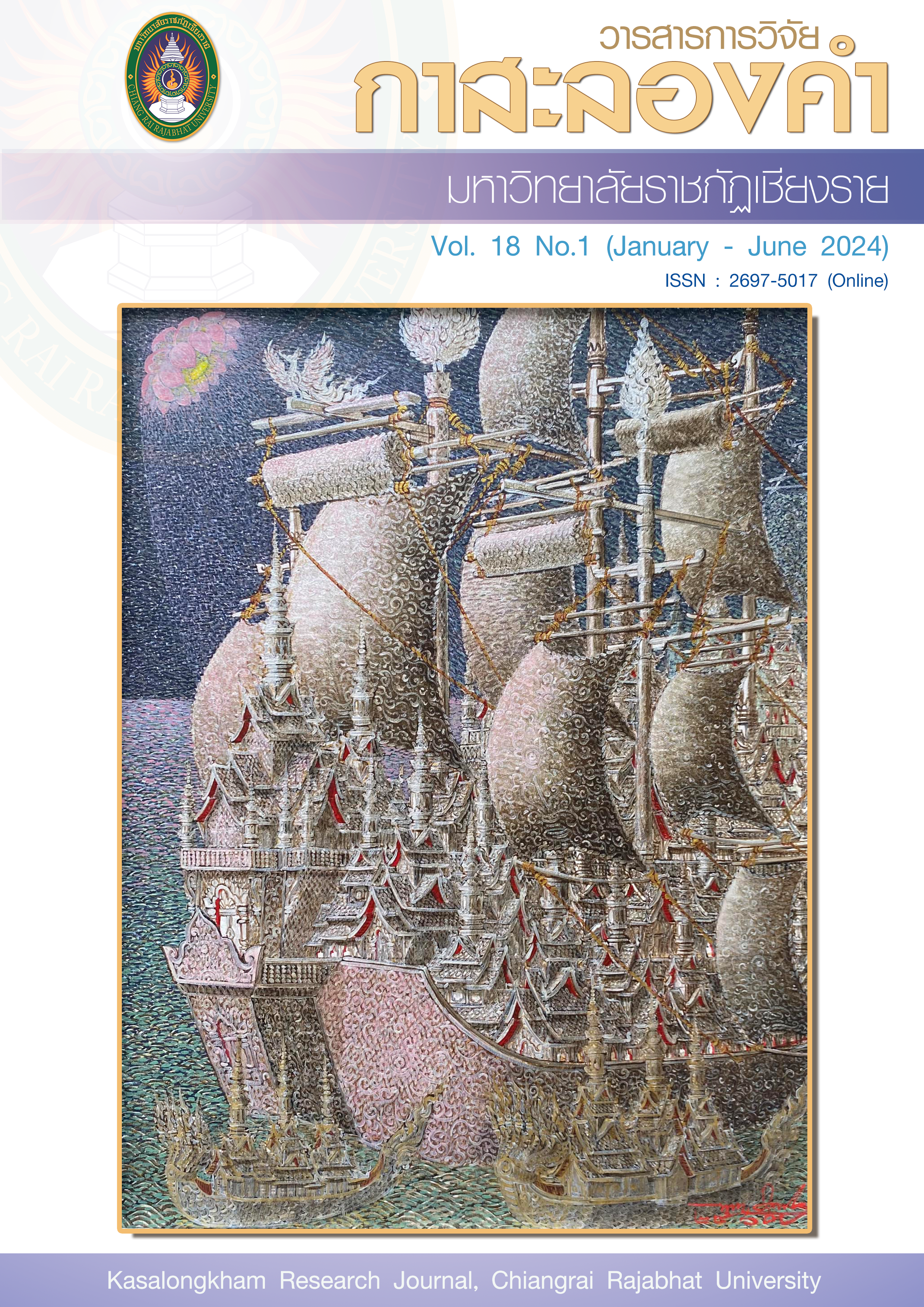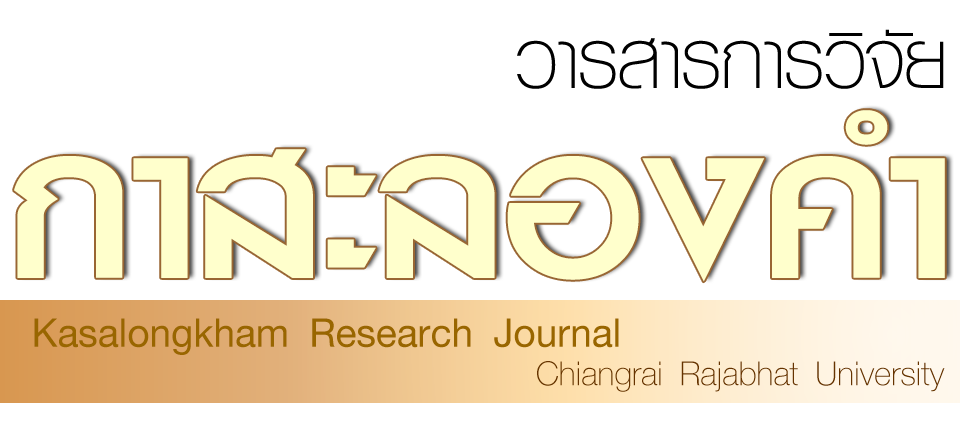โมเดลความสัมพันธ์เชิงสาเหตุระหว่างการมุ่งนวัตกรรมธุรกิจ ความสามารถ การเป็นผู้ประกอบการ โอกาสในการประกอบการ และผลการดำเนินงาน ของกิจการสตาร์ทอัพในประเทศไทย
คำสำคัญ:
การมุ่งนวัตกรรมธุรกิจ, กิจการสตาร์ทอัพ, ความสามารถการเป็นผู้ประกอบการ, ผลการดำเนินงาน, โอกาสในการประกอบการบทคัดย่อ
การวิจัยครั้งนี้มีวัตถุประสงค์เพื่อศึกษาโมเดลความสัมพันธ์เชิงสาเหตุระหว่างการมุ่งนวัตกรรมธุรกิจ ความสามารถการเป็นผู้ประกอบการ โอกาสในการประกอบการ และผลการดำเนินงานของกิจการสตาร์ทอัพ โดยใช้แบบสอบถามเป็นเครื่องมือในการเก็บรวบรวมข้อมูลจากผู้ประกอบการของกิจการสตาร์ทอัพในประเทศไทย จำนวน 300 คน ตัวแปรที่ใช้ในการวิจัย ประกอบด้วยตัวแปรแฝงภายนอก จำนวน 1 ตัวแปร คือ การมุ่งนวัตกรรมธุรกิจ ตัวแปรแฝงภายใน จำนวน 3 ตัวแปร คือ ความสามารถการเป็นผู้ประกอบการ โอกาสในการประกอบการ และผลการดำเนินงาน โดยวัดจากตัวแปรสังเกตได้ 15 ตัว แบบสอบถามที่ใช้ เป็นเครื่องมือมีค่าสัมประสิทธิ์ความเที่ยงตั้งแต่ 0.912 ถึง 0.947 และมีค่าความแปรปรวนเฉลี่ยของตัวแปรแฝงที่สกัดได้อยู่ระหว่าง 0.776 ถึง 0.845 สถิติที่ใช้ในการวิเคราะห์ข้อมูล คือ การวิเคราะห์โมเดลสมการโครงสร้าง (SEM)
ผลการวิจัย พบว่า ความสามารถการเป็นผู้ประกอบการเป็นปัจจัยเชิงสาเหตุที่มีอิทธิพลทางตรงต่อโอกาสในการประกอบการ มากที่สุด รองลงมา พบว่า การมุ่งนวัตกรรมธุรกิจมีอิทธิพลทางตรงต่อความสามารถการเป็นผู้ประกอบการ นอกจากนี้ผลการวิเคราะห์ข้อมูลยังพบว่า โมเดลการวิเคราะห์ความสอดคล้องกับข้อมูลเชิงประจักษ์ มีความเหมาะสมพอดีกับข้อมูลเชิงประจักษ์อยู่ในเกณฑ์ดี ดังนั้น ผู้ประกอบการกิจการสตาร์ทอัพในประเทศไทยควรพัฒนาความสามารถการเป็นผู้ประกอบการโดยการให้ความสำคัญกับการแสวงหาทรัพยากรนวัตกรรมใหม่เพื่อนำมาพัฒนาความสามารถทางนวัตกรรมผลิตภัณฑ์ ความสามารถทางนวัตกรรมการจัดการ การตลาด การเงินและบัญชีอยู่เสมอ เพื่อสร้างความได้เปรียบทางการแข่งขันและผลการดำเนินงานที่สูงขึ้น ทั้งนี้ ตัวแปรในโมเดลสมการโครงสร้าง สามารถอธิบายผลการดำเนินงานของกิจการสตาร์ทอัพ ได้ร้อยละ 86.70, 82.10 และ 89.10
เอกสารอ้างอิง
Aaker, D. A., Kumar, V. & Day, G. S. (2001). Marketing Research. New York: John Wiley and Son.
Afriany, A. N., Ardiyanto, F., Sumantika, A. & Prakosa, A. (2021). An Entrepreneurial Capacity
Highlight In Feather Duster SMEs, Karanglo Village, Klaten Selatan District. Journal of
Physics: Conference Series, 1823(2021), 1-5.
Awolaja, A.M. (2020). Entrepreneurial Opportunity and Collaborative Research Efforts as
Panaceas for Improving Academic Entrepreneurship Among Ekiti State University Staff.
Archives of Business Research, 8(3), 42-52.
Ayinaddis, S. G. (2023). The effect of innovation orientation on firm performance: evidence
from micro and small manufacturing firms in selected towns of Awi Zone, Ethiopia.
Journal of Innovation and Entrepreneurship, 12(26), 1-19.
Barclay, D., Higgins, C. & Thompson, R. (1995). The partial least squares (PLS) approach to
causal modeling:Personal computer adoption and use as an illustration. Technology
studies, 2(2), 285-309.
Barney, J. (1991). Firm Resources and Sustained Competitive Advantage. Journal of
Management, 17, 99-120.
Chhabra S., Callander, N., Watts, N.L., Costa, L.J., Thapa, B., Kaufman, J.L., Laubach, J., Sborov,
D.W., Reeves, B., Rodriguez, C., Chari, A., Silbermann, R., Anderson, L.D. Jr, Bal, S.,
Dhakal, B., Nathwani, N., Shah, N., Medvedova, E., Bumma, N., Holstein, S.A., Costello,
C., Jakubowiak, A., Wildes, T.M., Schmidt, T., Orlowski, R.Z., Shain, K.H., Cowan, A.J.,
Dholaria, B., Cornell, R.F., Jerkins, J.H., Pei, H., Cortoos, A., Patel, S., Lin, T.S., Usmani,
S.Z., Richardson, P.G., & Voorhees, P.M. (2023). Stem Cell Mobilization Yields with
Daratumumab- and Lenalidomide-Containing Quadruplet Induction Therapy in Newly
Diagnosed Multiple Myeloma: Findings from the Master and Griffin Trials.
Transplantation and Cellular Therapy, 29(3), 1-10.
Chow, W.S. & Chan, L.S. (2008). Social network, social trust and shared goals in organizational knowledge sharing. Information and
Management, 45(7), 458-462.
Dankwah, J.B., Nnindini, S.I. & Bukari, Z. (2024). Innovation orientation and firms' financial
performance: The moderating role of new product development Innovation
orientation and firms' financial performance: The moderating role of new product
development. Cogent Business & Management, 11(1), 1-16.
Fan, J. & Su, J. (2021). Influence of Social Network Strength on Entrepreneurial Opportunity
Recognition: A Chain Mediation Model of Need Knowledge and Technological
Knowledge. Discrete Dynamics in Nature and Society, 2021, 1-10.
Farooq, R., Vij, S. & Kaur, J. (2021). Innovation orientation and its relationship with business
performance: moderating role of firm size. Measuring Business Excellence, 25(3), 1-19.
Fornell, C. & Larcker, D.F. (1981). Evaluating structural equation models with unobservable
variables and measurement error. Journal of Market Research, 18(1), 39-50.
Gao, H. & Raju, V. (2023). Entrepreneur Ability and Firm Growth: A Review Paper. Journal of
Reproducible Research, 1(1), 61-66.
Gumel. B.I. (2018). Critical Factors Influencing Opportunity Recognition and Exploitation.
International Journal of Contemporary Research and Review, 9(4), 20748-20759.
Hair, J.F., Black, W.C., Babin, B.J. & Anderson, R.E. (2010). Multivariate data analysis: A global
perspective (7th ed.). New Jersey: Pearson Education Inc.
Jungang, W. (2023). The Effect of Product Innovation and Product Variations on Consumer
Buying Interest. Siber International Journal of Digital Business (SIJDB), 1(1), 25-33.
Kamau, A. ., Nkaabu, C., & Cherono, V. . (2023). Innovation Orientation and Firm Performance:
The Role of Organizational Commitment among Commercial Banks in Meru County,
Kenya. Human Resource and Leadership, 3(1), 29–47.
Kastelli, L., Siokas, G. & Tsakanikas, A. (2023). Entrepreneurial Absorptive Capacity as Enabler
of Knowledge Intensive Entrepreneurship: An Empirical Investigation. Journal of the
Knowledge Economy, 2023, 1-32
Khin, S. & Lim, T.H. (2018). Entrepreneurial opportunity recognition, Exploitation and new
venture success: Moderating role of prior market and Technology knowledge.
International Journal of Entrepreneurship, 22(4), 1-6.
Kuckertz, A., Hinderer, S. & Röhm, P. (2019). Entrepreneurship and entrepreneurial
opportunities in the food value chain. Science of Food, 3(1), 6.
Li, Z., Jiang, B., Bi, S., Feng, J. & Cui, Q. (2022). Impact of different types of entrepreneurial alertness
on entrepreneurial opportunities identification. Frontiers in Psychology, 13, 1-19.
Lv, R.W., Lai, C. and Liu, J. (2015). Entrepreneurial Capability Scale and New Venture Performance: The Moderating Role of Entrepreneurship education. Mediterranean Journal of Social Sciences, 7(1), 97-104.
Mohedano-Suanes, A., Revilla-Camacho, M. A. & Garzón, D. (2021). Innovation orientation and
long-term performance: The mediating role of market perception capability.
International Entrepreneurship and Management Journal, 17(1), 741–757.
Musawa, M.S., & Ahmad, K. (2019). Entrepreneurial Orientation and Innovation Performance:
The Moderating Role of Competitive Environment. Journal of Global Economics, 7(1), 1-7.
Nawir, C.P. & Christiani, N. (2019). The Effect of Entrepreneurial Passion and Opportunity
Awareness toward the Sustainability of Startup Businesses. Journal of Entrepreneur
and Entrepreneurship, 8(1), 33-40.
National Innovation Agency (Public Organization). (2023). sarup 3 praden samkhan chak ngan SITE
pakmut phatna sattat up thai ok su talatlok. Retrieved March 16, 2023, from https://nia.or.th/Thai-Startup-2023. (In Thai)
Nunnally, J.C. (1978). Psychometric theory. New York: McGraw-Hill.
Nunnally, J.C. & Bernstein, I.H. (1994). Psychometric Theory. (3rd ed.). New York, NY:McGraw-Hill.
Oyson, M. J. (2014). Entrepreneurship in Small Firm Internationalisation. (degree of Doctor of
Philosophy in Management Thesis). The University of Auckland.
Rachmawati, R. & Widowati. (2021). Research of the Impact of Financial Dimensions and Entrepreneurial Capacity on Business
Performance in Small and Medium Enterprises In Central Java. Universal Journal of Accounting and Finance, 9(1), 122-129.
Rattanasombat, B. (2023). Thunkit lae prathet chatoepto tong chai nawatkam lae kan talat pen Tuanam Retrieved August 2, 2023, from
https://www.bangkokbiznews.com/business/economic/1074309. (In Thai)
Schumacker, R. E. & Lomax, R. G. (2010). A beginner’s guide to structural equation modeling. (3rd ed). New Jersey: Lawrence Erlbaum Associates.
Soelaiman, L. & Liediana, L. (2020). Factors Affecting Entrepreneurial Opportunity Recognition Among Food and Beverage SMEs. Advances in Economics, Business
and Management Research, 174, 501-507.
Stanić, M. (2020). Decoding the Entrepreneurial Capacity: The Case of Entrepreneurial Alertness. Zagreb International Review of Economics & Business, 23, 1-12.
Stock, G.N., McDermott, C. & McDermott, M. (2018). Early Stage Venture Strategy and the Survival of Nascent Entrepreneurial Firms: A Sand Cone Model Approach.
IEEE Engineering Management Review, 46(3), 108-116.
Suriyawong, S., Panthai, B., Gatesa, T., Amornratanasak, S., Ruangsri, S. and Sethawong, P. (2008). Educational Research and Statistics: wichai lae sathiti thang kan
suek sa (3rd ed). Bangkok: Academic promotion center publishing. (In Thai)
Taleb, S.T.T., Hashim, N. & Zakaria, N. (2023). Entrepreneurial Leadership and Entrepreneurial Success: The Mediating Role of Entrepreneurial Opportunity
Recognition and Innovation Capability. Sustainability, 15(7), 1-17.
Technology and Innovation Based Enterprise Development Fund. (2023). Rai ngan pra cham Pi 2565 Annual Report 2022. Retrieved August 20, 2023, from
https://tedfund.mhesi.go.th/images/news/reports/2565/ARTED2022.pdf (In Thai)
Thoumrungroje, A. & Racela, O.C. (2022). Innovation and Performance Implications of Customer-Orientation across Different Business Strategy Types. Journal of
Open Innovation: Technology, Market, and complexity, 8, 178.
Zhang, H., Hu, L. & Kim, Y. (2023). How Does Iteration of Entrepreneurial Opportunities in User Enterprises Affect Entrepreneurial Performance? A Dual Case Study
Based on Dual Strategic Orientations. Systems, 11(9), 1-21.

ดาวน์โหลด
เผยแพร่แล้ว
รูปแบบการอ้างอิง
ฉบับ
ประเภทบทความ
สัญญาอนุญาต
ลิขสิทธิ์ (c) 2024 วารสารการวิจัยกาสะลองคำ มหาวิทยาลัยราชภัฏเชียงราย

อนุญาตภายใต้เงื่อนไข Creative Commons Attribution-NonCommercial-NoDerivatives 4.0 International License.





